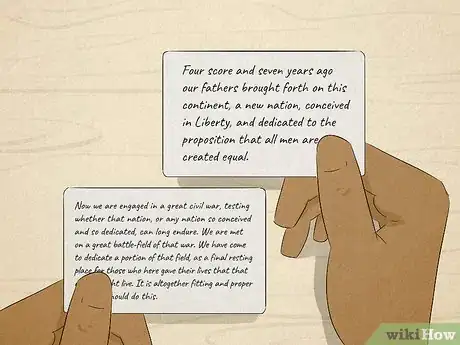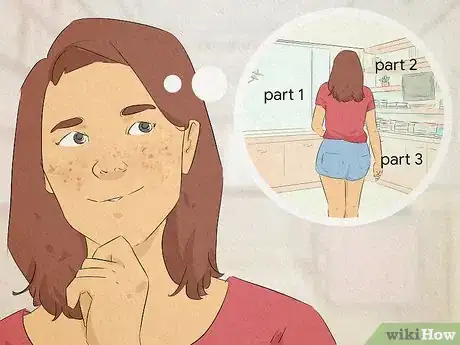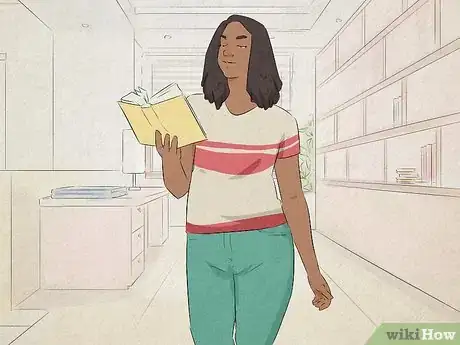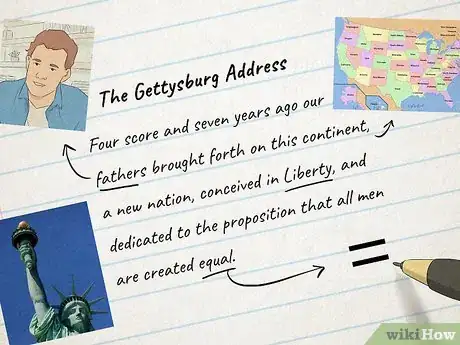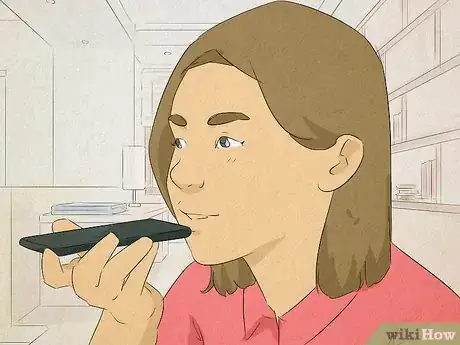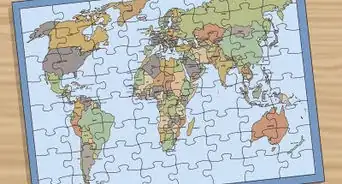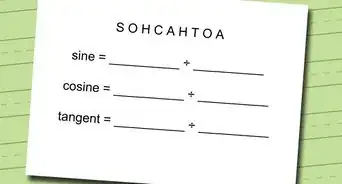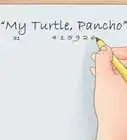This article was co-authored by Alexander Ruiz, M.Ed. and by wikiHow staff writer, Jennifer Mueller, JD. Alexander Ruiz is an Educational Consultant and the Educational Director of Link Educational Institute, a tutoring business based in Claremont, California that provides customizable educational plans, subject and test prep tutoring, and college application consulting. With over a decade and a half of experience in the education industry, Alexander coaches students to increase their self-awareness and emotional intelligence while achieving skills and the goal of achieving skills and higher education. He holds a BA in Psychology from Florida International University and an MA in Education from Georgia Southern University.
There are 15 references cited in this article, which can be found at the bottom of the page.
wikiHow marks an article as reader-approved once it receives enough positive feedback. This article has 14 testimonials from our readers, earning it our reader-approved status.
This article has been viewed 358,919 times.
If you've ever tried to memorize an essay, monologue, long answer, or other text, you likely just repeated the words over and over again until you could recite them from rote memory. However, this isn't necessarily the quickest way to memorize something and if you're working with a longer text you may not have the time it would take to keep repeating it aloud. Instead, use memorization techniques that suit your learning style and focus on recalling the text rather than rote memorization.[1]
Steps
Breaking the Text into Chunks
-
1Divide the text into separate actions or objectives. Once you read through the text you want to memorize a few times, patterns will start to emerge. Use these patterns or themes in the text to split it up into smaller units. Your units won't necessarily correspond to whole paragraphs or even whole sentences. Rather, each smaller unit should discuss a single idea.[2]
- For example, if you're trying to memorize Abraham Lincoln's Gettysburg Address, your first chunk might be the first line of the speech, in which Lincoln talks about the founding of the United States. The second chunk might relate to Lincoln's description of the civil war, then the third to the battlefield Lincoln was consecrating that day. Despite being separate chunks, the second and third chunks make up the same paragraph.[3]
- Look for phrases you already know that you won't have to work as hard to commit to memory. For example, if you already remember the phrase "four score and seven years ago" from the Gettysburg Address, you don't need to worry about memorizing that.
- Sometimes it can also help to reformat the text. You might hand-write or type the text out with plenty of space between the chunks. You might even include separate headings for each of the chunks.
-
2Practice each chunk separately. Now that you've found your chunks, start with the first one and repeat it until you feel comfortable with it and can recite it without looking at the text. Then move on to your second chunk and do the same.[4]
- Get a good familiarity with each of the chunks separately before you start to combine them. If there is a particular area of your original chunk that's giving you trouble, try separating it into even smaller chunks. Then you can combine those smaller chunks together once you've got them down.
Advertisement -
3Combine the first chunk with the second chunk. Once you have a handle on your chunks, it's time to put them together so you can eventually memorize the whole text. Start with the first text and try to recite it from memory. But this time, instead of stopping with the first chunk, move on to the second chunk.[5]
- Practice the first and second chunk together until you can recite them flawlessly. Then you're ready to add the third chunk.
-
4Repeat the process until you've memorized the entire text. Once you have the first and second chunk combined as a unit, move on to the third chunk and practice all three together. This reinforces your memory of the earlier chunks as well. Keep adding new chunks until you've reached the end of the text you want to memorize.[6]
- If you run into rough spots, stop and go back over them until you can recite them smoothly. Then integrate that part into the rest of the chunk.
- Throughout the process, keep your eye out for transitions that you can use as triggers to combine the chunks together seamlessly. If these transitions aren't in the text, add them mentally to help you connect the chunks — just remember not to say them out loud.
Creating a Memory Palace
-
1Map out a familiar place in your mind. The memory palace technique, also known as the "loci technique," has been around since the ancient Greeks. The idea is to think of a familiar place in your mind, then attach the text you want to memorize to the location you already have memorized. That place becomes your "memory palace."[7]
- It's often easiest to use your home, since you're intimately familiar with the rooms and the objects inside.
- Your place can also be a fictitious place that you're deeply familiar with. For example, if you're a big fan of Harry Potter and have a familiar map in your head of Hogwarts, you could use that.
- Your "memory palace" doesn't have to be a single building or location. It can also be a route from one place to another. For example, you might use your route from home to work or school.
-
2Assign parts of the text you want to memorize to rooms in the "palace." Go through your text and break it down into small bits. These could be as short as phrases or as long as paragraphs. Think about the rooms in your "memory palace" and the objects within them. Set a logical starting point and start connecting bits of the text to the objects in the room. The objects don't necessarily have to exist in the room. You can simply place them there in your mind.[8]
- For example, if you're trying to memorize Hamlet's soliloquy, you might imagine a letter "B" on the door of a room. When you open the room, there are arrows and slingshots pelting you from a large bag of gold coins. If you close the door and move down the hall, there are arms reaching out that grab you and carry you across a turbulent ocean.[9]
-
3Walk through your palace to connect the pieces together. When you enter your palace mentally and walk through it, you'll encounter each piece of the text you're trying to memorize. Thread them together as you move through the palace, always taking the same route each time. It will probably take several walkthroughs for you to have the text down, but each walkthrough will reinforce your mental association between the visual image and the text.[10]
- If you encounter pieces that are difficult to remember, you may want to rethink the object you have associated with that piece or break it up into smaller pieces associated with multiple objects.
-
4Use the mental image to recall the text you want to memorize. When you want to recite the text you've memorized, take yourself mentally back to your memory palace. As you walk through the rooms, recite the text based on the objects you encounter.[11]
- This technique may take some practice to master. If you're up against a deadline, it may not be the best time to create a memory palace. However, once you've used it a few times, you may find it enables you to memorize text more quickly.
- If you used a route rather than a place, you can travel through the text you're trying to memorize every day as you head to work or school. You could even try it in reverse as you go back home. Then you'd be able to say you know the text "backward and forward."
Trying Other Memorization Techniques
-
1Memorize the first letter of each word of the text to create a shortcut. Memorizing something is as much about your ability to recall the information as it is about committing it to your memory. To exercise your ability to recall, make a new page with only the first letter of each word in the text. Include punctuation so you can identify sentences and pauses. Then try to recall the text using only those first letters.[12]
- For example, if you were trying to memorize Hamlet's soliloquy from Shakespeare's Hamlet, you would write "t b, o n t b? t i t q — w 't n i t m t s t s a a o o f, o t t a a a s o t, a, b o, e t?"[13] Then you would see how many words you could get just from those first letters.
- Circle the letters that correspond to words you couldn't remember and then go back to the text. Use your favorite memorization technique to better commit those words to your memory in the context of the text, then try the first letters again.
- This trick is also useful if you're trying to recall something you memorized a long time ago but haven't thought about since. You might be surprised how much you'll recall.
-
2Turn the words into a song to help you remember them. The melody and rhythm of a song attach to the text and make it easier for you to remember. Use a familiar melody or a favorite song that you can fit the text into. It doesn't matter if the lines rhyme (they likely won't), as long as you can make it work as a song.[14]
- If you're musically inclined, you could try recording yourself playing the song. You may also be able to find an instrumental version of the song on your favorite streaming service.
- Educational programs, such as "Schoolhouse Rock," often create songs for historical documents and speeches. Search the internet or your favorite video streaming service and see what you can find.
-
3Walk around as you recite the memorized text to stimulate your brain. Once you've committed the text to memory, you'll find you have better recall if you're able to move around while reciting it — especially if you were moving around while you memorized it. Being active stimulates blood flow to your brain to make it easier to recall a text you've memorized.[15]
- Feel free to gesticulate as well to really get into the emotion of the text. The more passion and emotion you attach to it, the better you'll be able to remember it.
-
4Connect images to the text if you're a visual learner. You may find it easier to remember pictures than words, in which case this technique might work for you.[16] Similar to the memory palace technique, try to come up with an image for each of the main words in the text. Your brain will typically be able to fill in articles and other small words automatically.[17]
- For example, if you were trying to memorize Abraham Lincoln's Gettysburg Address, you might think of an image of your father, an image of the United States, an image of the Statue of Liberty, and an equal sign to represent the first line: "Four score and seven years ago our fathers brought forth on this continent a new nation, conceived in Liberty, and dedicated to the proposition that all men are created equal."
- If you enjoy emoji, you might try "translating" the text into emoji. Since those images are already familiar to you, it might make the text easier to remember.
- Writing the passage over and over may also help if you're a visual learner.[18]
-
5Record yourself reading the text if you're an auditory learner. Some people can more easily commit things to memory by listening to them over and over. If that's you, record yourself reading the text you want to memorize so you can listen to it. The act of speaking and listening may enhance your memory.[19] [20]
- If you dislike the sound of your own voice, you can always get someone else to read the text for you. However, you'll get less of a benefit by listening to someone else's voice than you would if you listened to your own voice.
- If you're trying to memorize a relatively famous text, you may also be able to find recordings online of famous actors or other celebrities reading the text.
Expert Q&A
-
QuestionHow can I memorize text if I'm an auditory learner?
 Alexander Ruiz, M.Ed.Alexander Ruiz is an Educational Consultant and the Educational Director of Link Educational Institute, a tutoring business based in Claremont, California that provides customizable educational plans, subject and test prep tutoring, and college application consulting. With over a decade and a half of experience in the education industry, Alexander coaches students to increase their self-awareness and emotional intelligence while achieving skills and the goal of achieving skills and higher education. He holds a BA in Psychology from Florida International University and an MA in Education from Georgia Southern University.
Alexander Ruiz, M.Ed.Alexander Ruiz is an Educational Consultant and the Educational Director of Link Educational Institute, a tutoring business based in Claremont, California that provides customizable educational plans, subject and test prep tutoring, and college application consulting. With over a decade and a half of experience in the education industry, Alexander coaches students to increase their self-awareness and emotional intelligence while achieving skills and the goal of achieving skills and higher education. He holds a BA in Psychology from Florida International University and an MA in Education from Georgia Southern University.
Educational Consultant I'm also an auditory learner and what I usually do is record something to be able to play it back to myself so I can really listen to the ins and outs of it. You should also try writing when you're listening, as repetition is key for memorization.
I'm also an auditory learner and what I usually do is record something to be able to play it back to myself so I can really listen to the ins and outs of it. You should also try writing when you're listening, as repetition is key for memorization. -
QuestionWhat is the easiest way to memorize text?
 Alexander Ruiz, M.Ed.Alexander Ruiz is an Educational Consultant and the Educational Director of Link Educational Institute, a tutoring business based in Claremont, California that provides customizable educational plans, subject and test prep tutoring, and college application consulting. With over a decade and a half of experience in the education industry, Alexander coaches students to increase their self-awareness and emotional intelligence while achieving skills and the goal of achieving skills and higher education. He holds a BA in Psychology from Florida International University and an MA in Education from Georgia Southern University.
Alexander Ruiz, M.Ed.Alexander Ruiz is an Educational Consultant and the Educational Director of Link Educational Institute, a tutoring business based in Claremont, California that provides customizable educational plans, subject and test prep tutoring, and college application consulting. With over a decade and a half of experience in the education industry, Alexander coaches students to increase their self-awareness and emotional intelligence while achieving skills and the goal of achieving skills and higher education. He holds a BA in Psychology from Florida International University and an MA in Education from Georgia Southern University.
Educational Consultant There's no one one-size-fits-all answer here. The first thing you should do is understand your learning style to focus your studies accordingly. You can also try combining different styles to help with memorization.
There's no one one-size-fits-all answer here. The first thing you should do is understand your learning style to focus your studies accordingly. You can also try combining different styles to help with memorization. -
QuestionI have a panto and I have so many cues, words, expressions and solos to learn. How can I remember them all if writing it down would be too much work?
 wikiHow Staff EditorThis answer was written by one of our trained team of researchers who validated it for accuracy and comprehensiveness.
wikiHow Staff EditorThis answer was written by one of our trained team of researchers who validated it for accuracy and comprehensiveness.
Staff Answer wikiHow Staff EditorStaff AnswerBreak it up into chunks and practice with a partner. Then, try to combine similar chunks and practice them together. Your partner can help you with cues, but most of those you should be able to remember from rehearsals.
wikiHow Staff EditorStaff AnswerBreak it up into chunks and practice with a partner. Then, try to combine similar chunks and practice them together. Your partner can help you with cues, but most of those you should be able to remember from rehearsals.
References
- ↑ https://www.backstage.com/magazine/article/backstage-experts-answer-ways-quickly-memorize-lines-6719/
- ↑ https://www.facinghistory.org/resource-library/teaching-strategies/chunking
- ↑ http://www.abrahamlincolnonline.org/lincoln/speeches/gettysburg.htm
- ↑ https://psychcentral.com/lib/memory-and-mnemonic-devices/
- ↑ https://psychcentral.com/lib/memory-and-mnemonic-devices/
- ↑ https://courses.lumenlearning.com/boundless-psychology/chapter/step-1-memory-encoding/
- ↑ https://www.ncbi.nlm.nih.gov/pmc/articles/PMC4056179/
- ↑ https://plato.stanford.edu/entries/mental-imagery/ancient-imagery-mnemonics.html
- ↑ https://www.poetryfoundation.org/poems/56965/speech-to-be-or-not-to-be-that-is-the-question
- ↑ https://learningcenter.unc.edu/tips-and-tools/enhancing-your-memory/
- ↑ https://plato.stanford.edu/entries/mental-imagery/ancient-imagery-mnemonics.html
- ↑ http://www.productivity501.com/how-to-memorize-verbatim-text/294/
- ↑ https://poets.org/poem/hamlet-act-iii-scene-i-be-or-not-be
- ↑ https://blogs.unimelb.edu.au/sciencecommunication/2017/10/20/want-to-remember-something-better-put-it-in-a-song/
- ↑ https://www.nyfa.edu/student-resources/7-easy-monologue-memorization-tips/
- ↑ Alexander Ruiz, M.Ed.. Educational Consultant. Expert Interview. 18 June 2020.
- ↑ https://learningcenter.unc.edu/tips-and-tools/enhancing-your-memory/
- ↑ Alexander Ruiz, M.Ed.. Educational Consultant. Expert Interview. 18 June 2020.
- ↑ Alexander Ruiz, M.Ed.. Educational Consultant. Expert Interview. 18 June 2020.
- ↑ https://www.tandfonline.com/doi/abs/10.1080/09658211.2017.1383434
About This Article
To memorize a long text in the shortest time possible, start by splitting it into 1-2 sentence sections to make it easier to remember. Read the first section a few times. Then, cover the page and practice recalling the section from memory. You can say it aloud, in your head, or write it down on a new piece of paper. Once you’ve memorized the first section, move onto the next one. Whenever you start a new section, say or write the text from the beginning so you learn the flow between each section. Repeat the process until you’ve learned all of the sections of your text. For more tips, including how to memorize text by using pictures for each section, read on!


